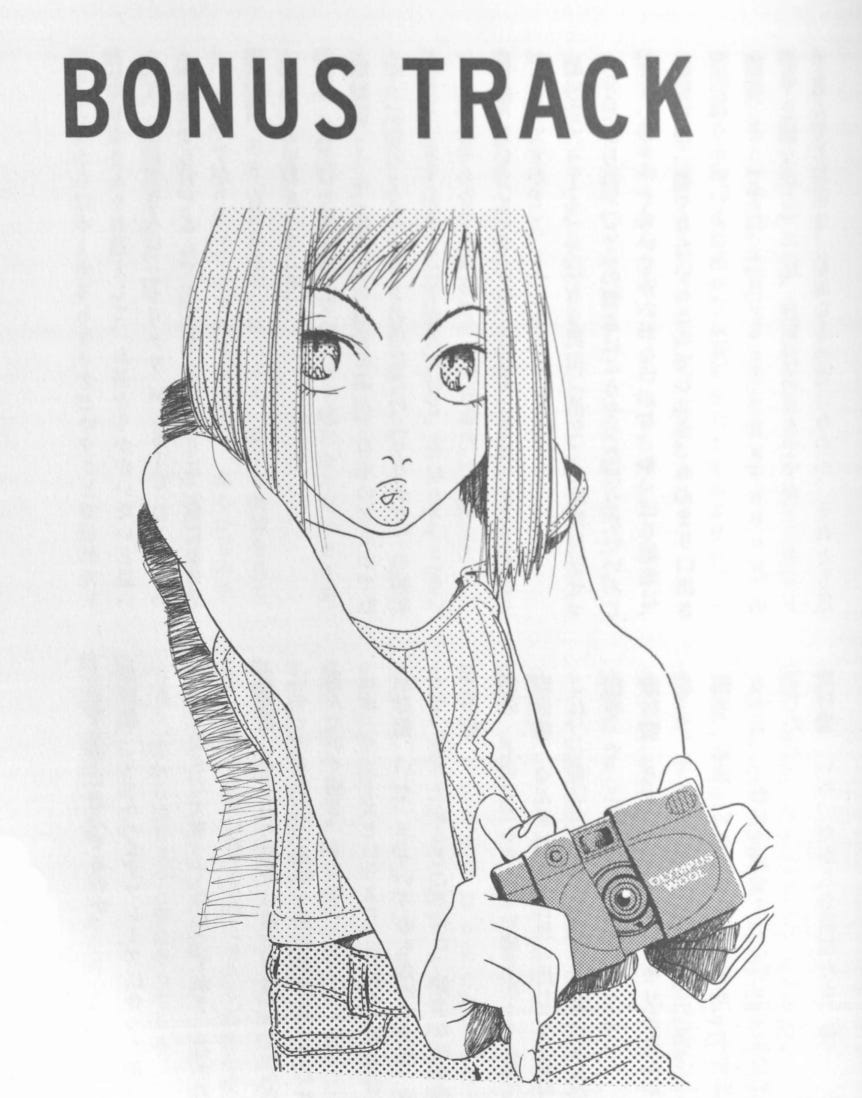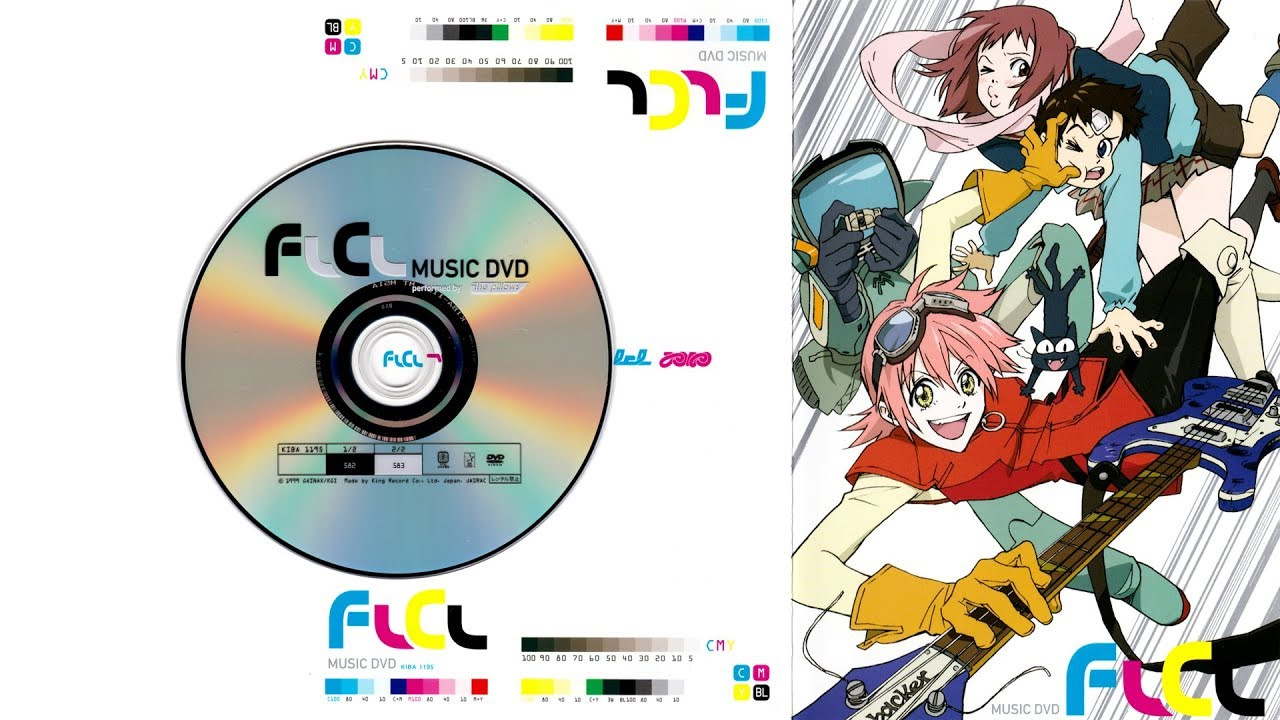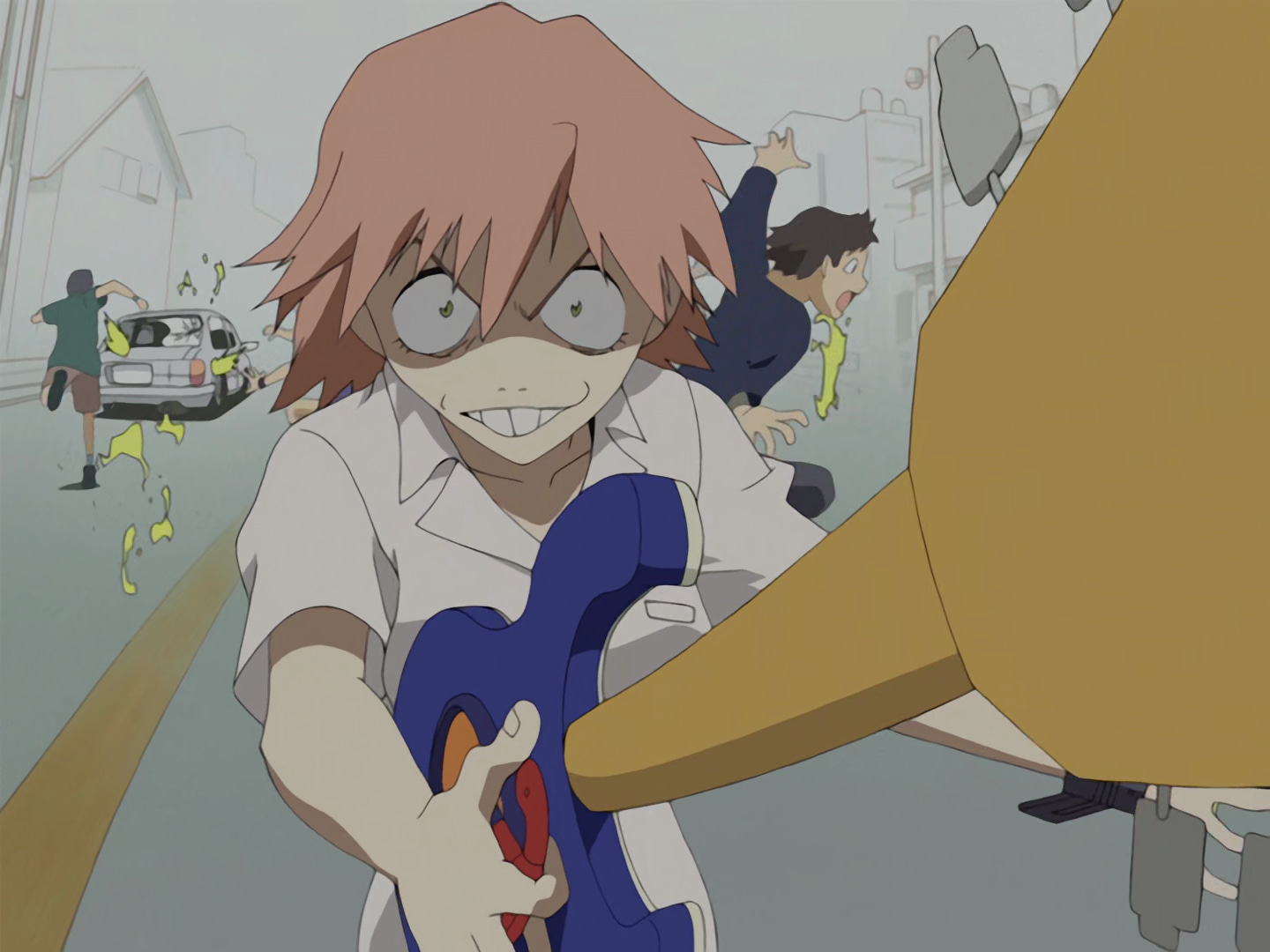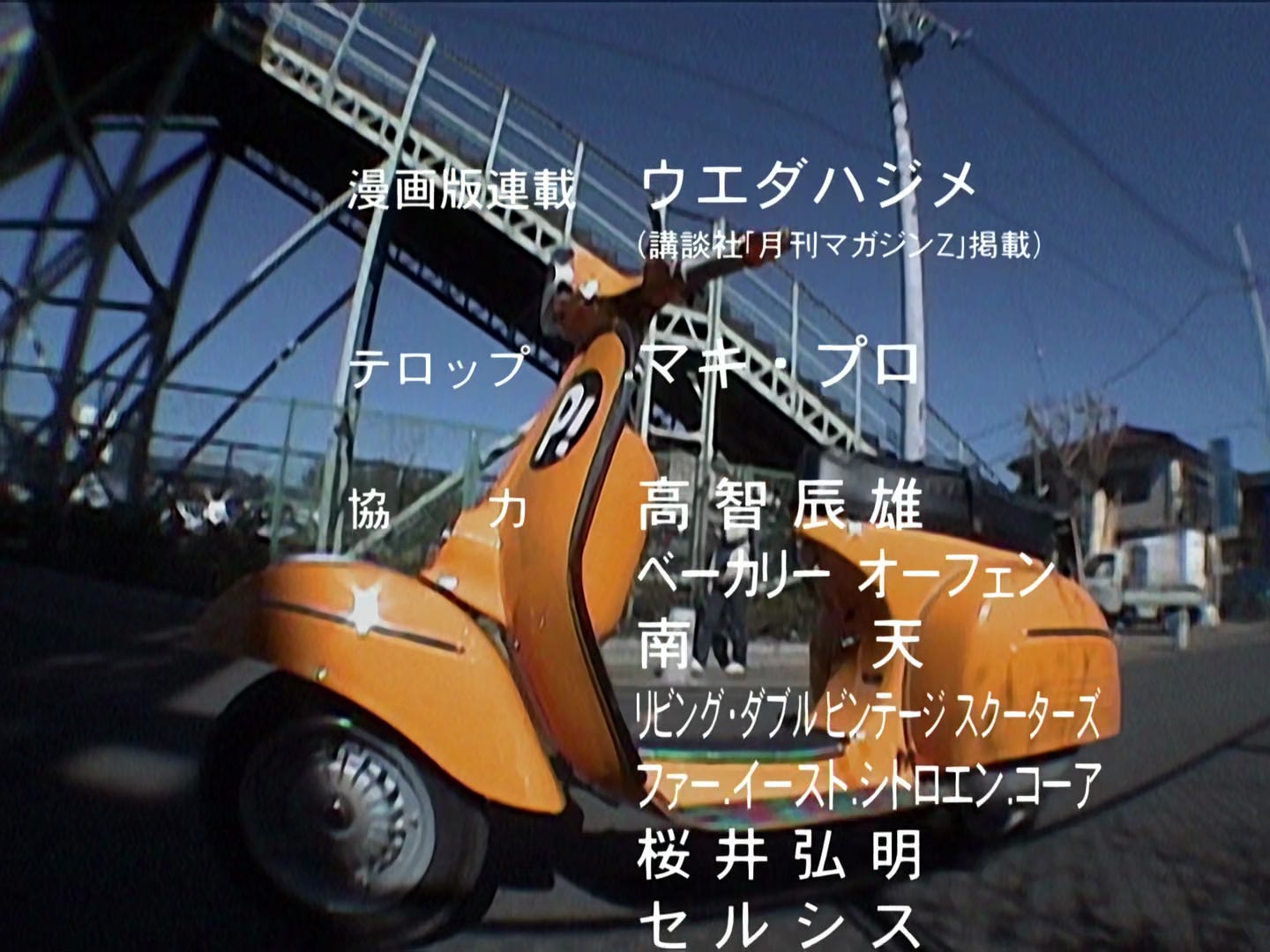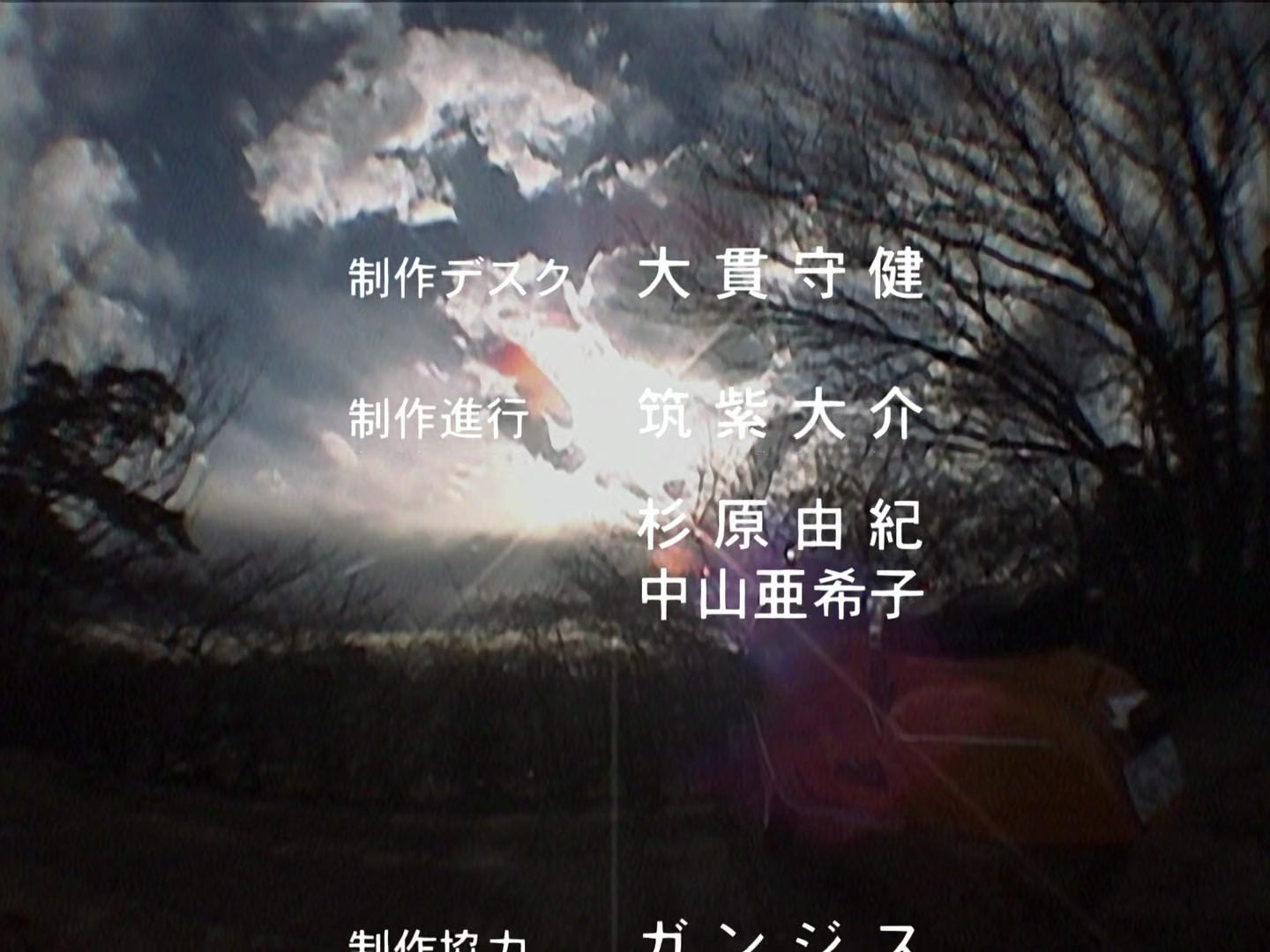[Table of Contents Available Here]
Special Guest - Masayuki: He was born in 1961 in Nagano Prefecture. He started his career at Studio Giants and later participated in Gainax productions, starting with "Royal Space Force." He teamed up with Tsurumaki and Sadamoto for numerous works, including "Nadia: The Secret of Blue Water," "Neon Genesis Evangelion," "FLCL," and also the "Evangelion: New Theatrical Edition" films. As mentioned during the interview, in FLCL he worked on the storyboards for Episode 2, key animation throughout the show, the ending sequence, and also took on tasks such as editing the "MUSIC DVD"1 promotional release.
Interviewer: Now, as a bonus track, we have invited guest Masayuki to join our discussion. Masayuki, you did the editing for the "FLCL MUSIC DVD," right? How does it feel to see it again after a long time?
Masayuki: ...Young, right?
Tsurumaki: Young, you say (laughs).
Sadamoto: You haven’t watched it since you finished working on it, right?
Masayuki: No, I haven't watched it. It's probably somewhere on a hard drive lying around in my home. I don't do this kind of work anymore.
Tsurumaki: By ‘young’, do you mean that you are more relaxed about things now?
Masayuki: Well, now I just leave everything to Hiroshi Okuda2 and Anno. I only say things like, "Shouldn't we connect these scenes like this?" Editing is probably something the chief director wants to do the most. It's better not to interfere too much (laughs).
Tsurumaki: Is that so? (While watching the PV for "Hybrid Rainbow") So, do you have any rationale for selecting the cuts? Is it based on the visuals only, or do you choose based on color or other criteria?
Masayuki: Hmm, first, I select movements that fit the musical phrases.
Tsurumaki: So, you think movements are important? Like moving from right to left or from the foreground to the background...
Masayuki: Those aspects are adjusted later, but initially, I choose the cuts based on the meaning of the lyrics and the atmosphere of the song.
Sadamoto: So, rather than just the phrases, it's more the progression of the musical notes?
Masayuki: No, you use everything including that. It's not just the lyrics, but I also try adding flashy pictures to the exciting parts.
Tsurumaki: I sense a lack of commitment... (laughs)
Masayuki: Watching it now, it's all coming back to me (laughs). Oh, this one was primarily Naota and Mamimi.
Tsurumaki: And the second one is focused on Ninamori.
Masayuki: Yes, I think this one was focused on Ninamori and something else, if I recall right.
Tsurumaki: You have to remember all the cuts from various episodes to do this, I don’t think I could manage it.
Masayuki: That's why I watched all the episodes! I lined up all the visuals from episodes with sound removed.
Tsurumaki: It's not just about watching; probably, you have to remember all the cuts to do this. It's quite challenging.
Masayuki: Well, since it's a PV (promotional video), it's more about being cool rather than adhering to rules, right?
Tsurumaki: Well, that's true, but even so, you need some kind of rules; otherwise, it can be too difficult. If you try to use any visuals you want, you might get lost and be unable to proceed.
Masayuki: Ah, so the first step is to just try to connect something together. Then, like before, you will start to get ideas like "I think Mamimi is the top beauty”. Then I would pull out cuts from each episode that seemed to be related to that character, insert them, check again, and repeat the process.
Tsurumaki: It's like the whole thing comes together little by little. At first, you just try to connect things.
Masayuki: Also, for the chorus, it's probably better to use flashy visuals, so you pre-select those. Like for the end, what was the name of Haruko's boyfriend?
Tsurumaki: Atomsk.
Masayuki: Right, so like the scene where Atomsk leaves, for example.
Tsurumaki: When I see Anno creating trailers for 'Eva,' it looks like, "This is the 'Evangelion' block," "This is the character showcase block," it feels like organizing it block by block. Is it somewhat similar?
Masayuki: Yeah, its why I fully mobilize everything available.
Interviewer: How long did making this take?
Masayuki: Hmm... it took about a month or so.
Tsurumaki: For one song?
Masayuki: For two songs, "Come Down" and "Hybrid Rainbow," it took about two weeks each. Well, including rendering during processing.
Sadamoto: Do you sort of lay out the core images and then fine-tune it by timing?
Masayuki: No, usually, I first create the main section in full. I start with that part, then use certain other materials for the chorus, and then it becomes a bit easier for the second part. You just need to connect them. Once you see that...
Tsurumaki: Using the same tricks.
Masayuki: Yeah, well, I didn't make them exactly the same because that would be boring. I played around with it, like moving the darkness like we saw earlier, processing ripple effects to match the guitar phrases, adjusting cuts and frame counts, just experimenting more and more. But I remember that initially, I said, "It's impossible to do six songs," because I only had material from six episodes. So, I ended up finishing just two songs (laughs).
Tsurumaki: That's true.
Masayuki: The songs that Okuda edited have a lot of overlap with mine, don't they? He must have had a hard time.
Tsurumaki: Certainly, it couldn't be helped.
Masayuki: Well, you see, there are certain good parts of the visuals that I had already decided, like, "I surely want to use this and that part." However, it's been about ten years already [since I worked on it].
Sadamoto: It's amazing how popular FLCL is in Europe, even more so than in Japan. As well as for Eva, when you go to Europe or America, people ask you for autographs for FLCL.
Interviewer: In America, FLCL was heavily aired on late-night TV, right?
Sadamoto: In Europe, 'Nadia' and 'FLCL' are both quite popular, and you see a little bit of 'Eva' as well.
Masayuki: 'Eva' isn't popular overseas, is it?
Sadamoto: Well, it's actually popular in Italy, for some reason.
Masayuki: Really?
Sadamoto: Maybe it's a promotional thing, but when I went to France, I entered a restaurant run by Italians. When I told them I'm an artist from Japan, they asked, "What kind of art do you create?" So I drew some profiles of Evangelion characters, and after a while, three or four chefs came out one after another, asking, "Are you really involved with 'Eva'?" (laughs).
Interviewer: Ahahaha
Sadamoto: I said, "No, I'm just the character designer," and they replied, "Sign our plates for us!"
Masayuki: Was the cook a young guy?
Sadamoto: Yeah, he was a cool guy. The first person who came out seemed like his mother.
Masayuki: Ah, I get [the atmosphere] now.
Interviewer: Masayuki, beyond the MUSIC DVD, you worked on FLCL itself, right?
Masayuki: Um... I also helped with the key animation. I worked on the third and fifth episodes.
Tsurumaki: Like the part in the town with the slow-motion gunfight3.
Masayuki: Yeah, that part wasn't too great, was it?
Interviewer: No, no, no, that's not true (laughs).
Tsurumaki: I also asked you to do the storyboard for the second episode.
Masayuki: But most of it received corrections, right?
Tsurumaki: No, that's not true. I think there's quite a bit left in there.
Masayuki: No no, it wound up as a crisp, “Tsurumaki” episode in the end, I think!
Tsurumaki: Also, the ED was done by Masayuki. Oh right, let's talk about how tough the filming for the ED was.

Masasayuki: Ahahaha (laughs), we filmed for a long time, didn’t we?
Tsurumaki: Tsurumaki: And it was cold too, it was still early spring.
Masanori: And yet we got hot while we were doing it.
Tsurumaki: It was all the physical labor we did, wasn't it? (laughs)
Masayuki: It really was like doing physical labor (laughs). Moving the Vespa, shooting it, moving it again, shooting it again... We were helped by two producers, and the three of us worried about whether the others would show or not. Also, I remember getting sunburned at that time. It was February, you know.
Interviewer: Ahahaha (laughs)
Masayuki: We were out there all day long, so when we returned to Gainax, the manager (Hiroki Sato) said to me, "Were you drinking alcohol or something? Your face looks red!" (laughs). Well, it makes sense, considering we were outside for all that time.。
Tsurumaki: Seriously, live-action production is like physical labor compared to anime.
Masayuki: It's so difficult to keep passerbys out of the shot. It would be fine if regular pedestrians could just walk by, but it didn't work because it's stop-motion animation. Nowadays, you'd just remove them with CG.
Tsurumaki: I remember we started editing things out from the second or third episode. We got rid of the [Vespa] stands visible in the shot.
Masayuki: That's right. Is that yellow Vespa still around?
Tsurumaki: No, it's not.
Masayuki: Did you sell it?
Tsurumaki: I didn’t sell it, but I don’t have it.
Sadamoto: It's still sitting at the bike shop (laughs).
Masayuki: Huh, but you also ride a white Vespa, right? So what’s the story with the yellow one?
Tsurumaki: Well originally, that yellow was a somewhat special color, painted specifically for that bike.
Masayuki: Was it custom-made?
Tsurumaki: No, I found it that way.
Sadamoto: It's an extremely rare model, the 180SS. When we saw it I told Tsurumaki "You should buy it right away!" (laughs).
Tsurumaki: Ahahah (laughs).
Sadamoto: The one I ride is a modified 150, made to resemble the FLCL one. The previous owner painted it yellow like a Ducati (laughs).
Masayuki: But the FLCL model is more expensive than a regular Vespa, right?
Sadamoto: Well, it's not just that it’s expensive; it's that there are no more of them. There are probably only around 30 of them in Japan.
Interviewer: And then you knocked it over during filming and it fell into pieces (laughs).
Tsurumaki: We filmed once in Yokohama, but the weather wasn't good that day.
Masayuki: It got cloudy in the middle of filming. And then, the Ministry of Land, Infrastructure, Transport and Tourism showed up to complain.
Interviewer: The Ministry of Land, Infrastructure, Transport and Tourism? (laughs)
Masayuki: While we were shooting on the riverbank, an old man came over and scolded us (laughs). And while Sato was being scolded, we kept shooting (laughs).
Tsurumaki: In the end, as soon as the sun disappeared, the colors stopped coming out nicely
Masayuki: Well, clouds are always moving. It's not always going to be sunny
Tsurumaki: So I said, "Let's shoot it again," and we re-shot it near the former Gainax studio in Mitaka.
Interviewer: Were both of these shoots just one day's worth of work?
Tsurumaki: No, initially I think we spent quite a long time on it; certainly several days.
Masasetsu: We went to Yokohama, and some places like the promenade by the riverbed. We also went to parks along the Tama River.
Tsurumaki: Two days wouldn’t have been enough time.
Masayuki: And you know, when we were at Tama River, just Sato and I were shooting, and then the park's caretaker came over.
Tsurumaki: Ugh, again (laughs)
Masayuki: We were shooting for a test, and we thought "Let's come back again to shoot the actual scene," but then we got complaints about our presence. I asked Tsurumaki, "How is this shot, given it is the only one we have?" We used it, but the colors kept changing rapidly with the flow of the clouds, which was quite challenging to deal with.4

Interviewer: So the whole thing took quite a bit of time, then?
Tsurumaki: It did. We spent about a week on it, right?
Masayuki: I feel like it was even longer.
Tsurumaki: It was cold, and we were shooting in exposed areas, so it was tough with all the wind.
Masayuki: There were a lot of times when we were out there just waiting for the weather to change too.
Interviewer: Finally, Masayuki, looking back, what are your thoughts?
Masayuki: Well, what can I say... (laughs) It's like Tsurumaki-kun's youth is packed into it.
(Everyone laughs)
Tsurumaki: I was already over 30, so calling it my youth is a bit of a stretch (laughs).
Masayuki: But wasn't this show how you met your wife?
Tsurumaki: Was it really? (laughs).
Sadamoto: Yeah, that's right. Come to think of it, something that big did happen here.
Masayuki: Well then, this must have been a great time for you, right? (laughs)
Tsurumaki: Oh no, that was after FLCL was over...
Interviewer: I mean, are you sure that's how you feel about it (laughs)?
Masayuki: But seriously, until watching FLCL again here today, I had completely forgotten about it (laughs).
TN: A DVD compilation of The Pillows music set to edited clips of FLCL, as well as the band’s own music videos, issued in conjunction with the soundtrack release. You can watch some of it [here] if you want.
TN: The editor on the new Evangelion films at the time
TN: ~14:18 in Episode 5
TN: Pictured is what I think is the lower-quality Tama River shots in the ED. If you want a lot of detail on what shots were filmed where, you can check out this write-up an intrepid fan did.




